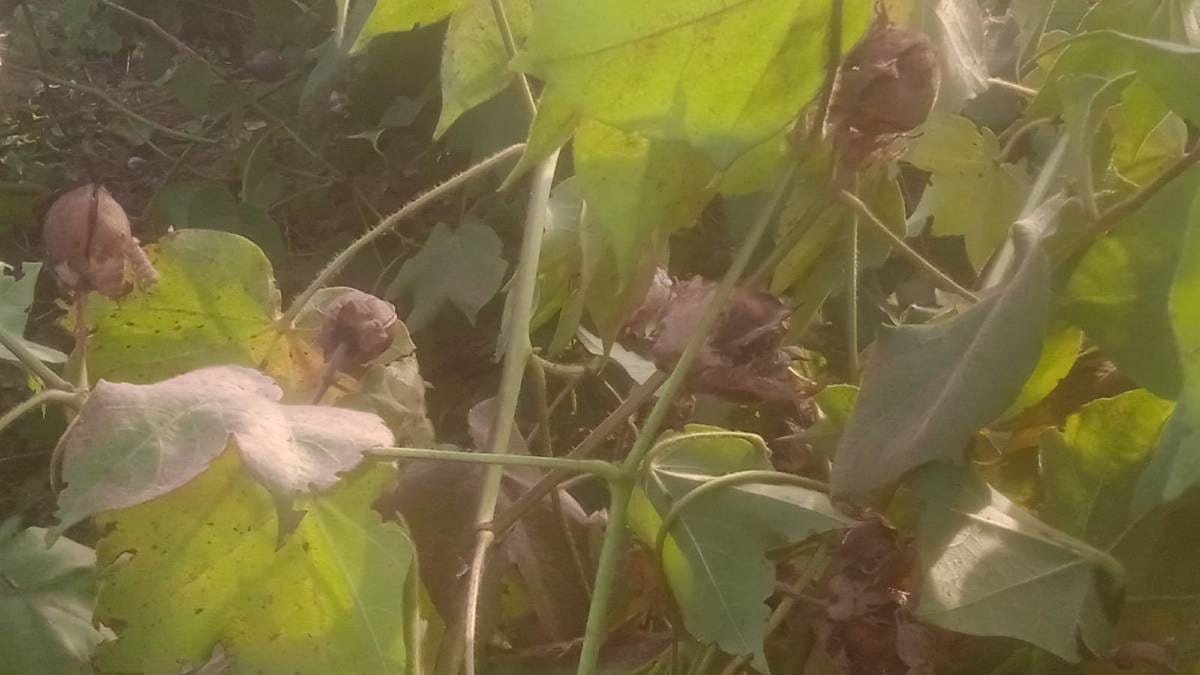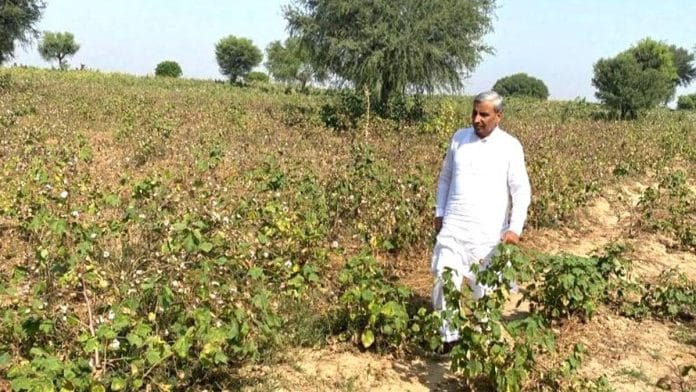Gurugram: For the second year in a row, cotton farmers in Haryana are seeing their crop go waste due to attacks from pests, mainly the common pink bollworm, and a fungal infection.
Ram Pratap Sihag, joint director (cotton) in the Haryana agriculture and farmers’ welfare department, confirmed that the attack from the bollworm was widespread and covered almost all 17 districts of the state where cotton is grown.
Speaking to ThePrint Tuesday, he said the damage to crops was more pronounced in Sirsa, Fatehabad and Hisar districts, which had the largest areas under cotton.
He added that the exact damage would be known when the farmers registered their claims on the e-kshatipurti portal and the damage was assessed by officials.
The pink bollworm is a most destructive insect that feeds on the cotton seed and destroys the plant fibre, reducing its quality as well as yield.
The damage to the Haryana cotton crop was highlighted by users on social media platform X Monday, when state agriculture and farmers’ welfare minister J.P. Dalal posted his pictures examining crops in a field.
“Inspected cotton crops on the way from Siwani to Bhiwani. I am a farmer’s son and I am always standing with the farmers in their times of happiness and sorrows,” Dalal had posted in Hindi.
The pictures of cotton fields showed withered crop with few cotton bolls (fluffy clumps on the plant). A number of people posted comments in response to Dalal’s post, stating that their cotton crop had been almost completely damaged by pests.
Ratti Ram, a cotton-producing farmer from Begu village of Sirsa district, told ThePrint that loss to the crop was 70 to 80 per cent in his village. Sirsa district is said to account for nearly one-third of the total cotton produced in Haryana.
“In normal circumstances, we get 10 to 12 quintals of raw cotton per acre. But this time, we are hardly getting 2 to 2.5 quintals an acre,” said Ram.
He also claimed that though the Manohar Lal Khattar government had said the e-kshatipurti portal would open from 1 October, he had not been able to register his loss because the “portal was not working”.
Dilawar Singh, another farmer from Begu village, said he had brought labourers from Sirsa Sunday to harvest his crop but they left after looking at its condition.
Labourers hired to pick cotton are paid on the basis of the weight of cotton picked by them.
“With more than 70 per cent of the crop damaged, the labourers said they wouldn’t be able to earn much after day-long hard work on the field,” Singh said.
Dr Rishi Kumar, principal scientist and head at Sirsa-based Central Institute for Cotton Research, a body of the Indian Council of Agriculture Research, told ThePrint that damage to cotton crops due to pests was widespread in Haryana as well as neighbouring Punjab and Rajasthan, though the extent varied from location to location.
“I can’t comment on the extent of the damage because the density of infection varies from location to location. But I can say that the range of infection is 40-45 per cent,” said Kumar.
He added that the cotton crop had been hit by the twin problems of pink bollworm infection and boll rot, a fungal infection.
In the previous 2022-2023 season, Haryana had recorded its lowest cotton yield over two decades after the pest-resistant Bt cotton variety fell prey to pests.
Attacks by the pink bollworm and whitefly, coupled with diseases like leaf curl and parawilt, burning of plants due to excessive heat in the initial days of planting of the crop, and unseasonal rain all contributed to the drop in yield.
Also Read: India’s most popular export variety of Basmati to be phased out. Farmers hopeful, exporters anxious
‘A tricky pest’
Om Prakash Garwa, a progressive farmer from Mehna Khera village of Rania Tehsil in Sirsa, told ThePrint that loss to the cotton crop was almost 100 per cent this season.
“We hardly have one or two quintals per acre of cotton left on the plants. In such a situation, the labourers demand Rs 18 to Rs 20 per kilogram for picking the crop against the normal rates of Rs 7 to Rs 8. In these conditions, we are not able to decide whether to get the leftover crop harvested or get the plants uprooted,” he said.
Garwa explained that he had planted cotton on his fields around 18 or 20 April this year and first sprayed pesticide in the first week of July.
“Since then, 13 rounds of pesticide have been sprayed with each round costing a little more than Rs 1,000 per acre. But now, at the time of harvest, the crop has been devoured by pests,” he rued.

According to Garwa, the pink bollworm wasn’t the only pest responsible for the damage this year, and a fungal infection has also hit the crops leaving the cotton bolls red in colour.
He added that the damage was so pronounced that “it won’t be possible to recover the input costs let alone earn profit”.
Kumar said that because of the concealed feeding behaviour of the bollworm, it was not possible to detect the pest till the time of harvest.
No amount of pesticide spray helps as the larvae sit hidden in the closed bolls, he explained, adding that the other problem with the pink bollworm was that it had no alternative host other than cotton, unlike the American bollworm and the spotted bollworm.
“Pink bollworm doesn’t have an alternative. For its survival, it has to find cotton crops. Also, the bollworm attacks the crop towards the end of the season when the Bt toxins present in the plants through its Bt cotton seed start diminishing, hence making the plant prone to pest attacks,” said Kumar.
Dr Dilip Monga, former head of CICR, told ThePrint that apprehensions were being expressed from the very beginning that the pink bollworm would surface this year and the fears had now come true.
“It is a very tricky pest because it doesn’t come out of the boll. By the time we come to know of the attack, the damage is already done,” Monga said.
He added that ‘pheromone traps are the only way to check this pest”. A pheromone trap is a type of insect trap in which pheromones are used to lure insects.
(Edited by Nida Fatima Siddiqui)
Also Read: Telangana is the success story of Indian agritech. AI tools, soil testing, e-commerce & more






